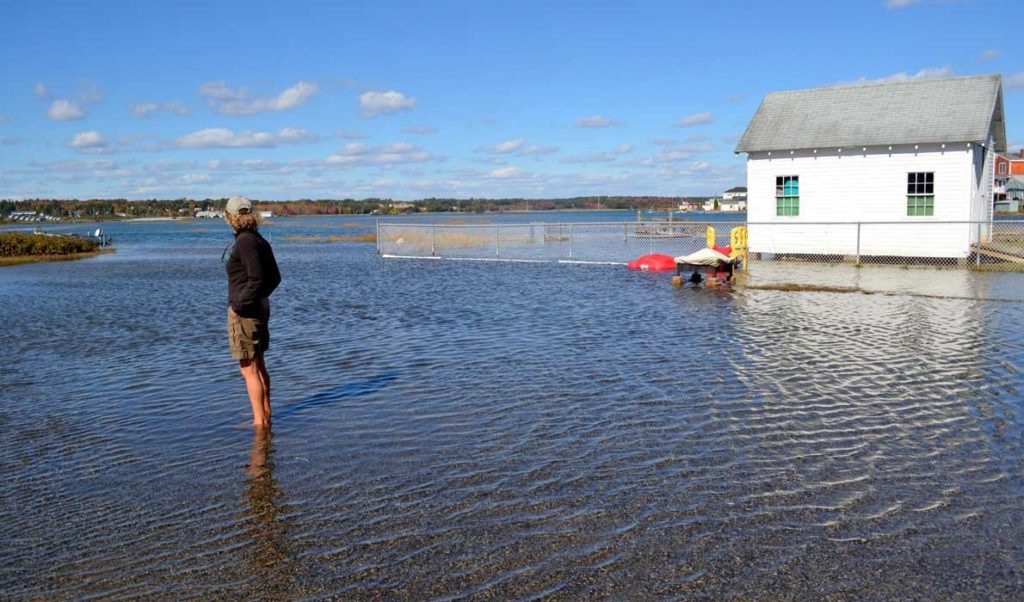When it comes to confronting climate change, how can we design responses to meet the needs of Maine’s rural and natural resource–based communities? How can we expand these considerations to ensure that climate action will serve all Maine people equitably—particularly those who have been excluded in the past, and who are hit hardest by climate impacts?
While much of the world came to a screeching halt this spring, members of the Maine Climate Council’s working groups doubled down on reaching the state’s climate goals. According to the Governor’s Office of Policy, Innovation, and the Future, the entity supporting the effort, more than 200 people across seven working groups participated in 30 meetings in April alone to refine strategies and review data toward meeting an early June deadline for submitting recommendations to the full council.
Island Institute staff serve on four of the council’s subgroups (science and technical; buildings, housing, and infrastructure; marine and coastal; and community resilience, emergency management, and public health), giving us insights into the cross-cutting nature of the council’s work, and the realities of Maine communities.
The legislation behind the Climate Council, LD 1679, calls for explicit consideration of rural communities; persons of low and moderate income; economic sectors facing the biggest barriers to emission reduction; vulnerable communities; and natural resource–based industries. The council’s plan must treat Maine people “fairly and equitably” and ensure “equity for all sectors and regions of the state.”
But as working groups began to compare proposals, the question arose: “How do we know we are making meaningful progress on equity and doing more than just ticking the box?”
At the Island Institute, we’ve seen how some residents of our state’s island and coastal communities can be left behind—usually unintentionally—by one-size-fits-all policy and program design. These communities are generally smaller and geographically isolated; tend to have residents who are older; have a higher share of people who are self-employed and working in natural resource–based industries; and can have limited internet access. Our work in communities has repeatedly shown that these characteristics can inhibit access to clean energy financing and other efforts to prepare for climate change.
Specifically, our 2018 “Bridging the Rural Efficiency Gap” white paper with the Maine Governor’s Energy Office high-lighted the geographic, financial, and awareness gaps rural communities face trying to access energy efficiency programs.
The Island Institute recognizes that some Mainers—along the coast or in the interior—face barriers to shaping or benefiting from carbon reduction for other reasons. Structural inequities disproportionately burden people of color, indigenous peoples, and low-income people with legacies of environmental damage and ongoing harm. How could we work with the council to consider these concepts, and ground them in real stories from across the state?
On April 28, I partnered with Ania Wright to co-present to the council’s Buildings, Infrastructure, and Housing Working Group, featuring researchand accounts of Maine communities and industries to illustrate how these ideas play out. Wright is the youth representative to the Climate Council, representing Maine Youth for Climate Justice and College of the Atlantic.
Young people are at the frontlines of the climate crisis, and yet the urgency they feel is not always heard. They see the climate crisis as a failure of our societal systems, not just an ecological crisis. Dealing with the climate crisis will take rethinking the way we solve problems by making commitments to equity and inclusion, and by acting on the needsof those who are being disproportionately affected and have historically been left out of climate action.
In our presentation, we noted:
• Rural residents—61 percent of Maine, the highest rate in the nation—face high reliance on expensive heating fuel, live in older houses and higher numbers of mobile homes, and have lower incomes, contributing to a higher percentage of household income spent on electricity and heating.
• Social vulnerability—an indicator shaped by factors such as poverty, agency, age, race, and economic diversity—is higher in rural Maine, in part due to limited available resources to address the impacts of climate change.
• Natural resource–based industries such as fisheries and forestry are particularly vulnerable to climate change, due to direct impacts and reliance on fossil fuels. Support for these disproportionately affected and economically essential industries is key to addressing climate change.
• Addressing these inequities is possible, in part by partnering with trusted messengers and adding funding and flexible financing.
These lessons are relevant to all the climate council’s working groups as they strive to support communities to reduce carbon pollution and adapt to the impacts of a changing climate. By doing so with an commitment to equity, as required by the legislation, we can ensure that state action will benefit all Mainers.
The Island Institute is encouraged by the climate council’s progress. While communities grapple with health and economic crises, and with how to dismantle systemic racism, we know that Maine people, and especially our most vulnerable residents, will be hit by increasingly strong storms, rising seas, uncertain growing seasons, and other climate impacts. There is much work to do, but our commitment to recommendations based on these realities will help all Mainers in the months and years ahead.
Suzanne MacDonald is chief community development officer for the Island Institute, publisher of The Working Waterfront. Ania Wright contributed to this op-ed.





